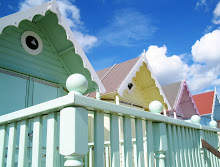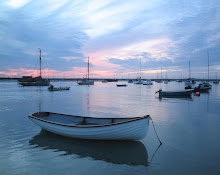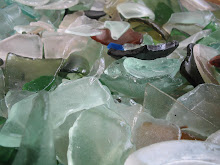 'There is a splendid irony in collecting sea glass, since this alluring trophy sought after in the shifting sand was once merely sand itself.'
'There is a splendid irony in collecting sea glass, since this alluring trophy sought after in the shifting sand was once merely sand itself.' Buying a copy of Pure Sea Glass: Discovering Nature's Vanishing Gems was sheer extravagant self-indulgence on my part, but given that This Sea Glass Thing seems to have taken off in all directions (see, for example, here), I felt in need of a good reference book.
Buying a copy of Pure Sea Glass: Discovering Nature's Vanishing Gems was sheer extravagant self-indulgence on my part, but given that This Sea Glass Thing seems to have taken off in all directions (see, for example, here), I felt in need of a good reference book. As might be expected, there's absolutely masses of information on the Internet, but as every right-minded bibliophile knows, there's nothing quite like a satisfyingly chunky hardback book, and Pure Sea Glass provides considerably more than mere 'satisfaction' - it's positively droolworthy!
As might be expected, there's absolutely masses of information on the Internet, but as every right-minded bibliophile knows, there's nothing quite like a satisfyingly chunky hardback book, and Pure Sea Glass provides considerably more than mere 'satisfaction' - it's positively droolworthy!
 The book distills the considerable knowledge of its author, Richard LaMotte, into easily digestible form. He and his wife, Nancy (who designed the book), have studied some 30,000 pieces of sea glass and one of their chief delights is in identifying the origin of each piece.
The book distills the considerable knowledge of its author, Richard LaMotte, into easily digestible form. He and his wife, Nancy (who designed the book), have studied some 30,000 pieces of sea glass and one of their chief delights is in identifying the origin of each piece.
'For several thousand years, civilizations have used the same natural ingredients - sand, soda, and lime - to create glass. Leave it to Mother Nature to improve upon something manipulated by man and returned to her care after it has served out temporary needs. The forces of nature not only shape sea glass by abrasive physical conditioning, but contact with aquatic environments creates unique textures that are only poorly imitated by man.'

Pure Sea Glass therefore not only discusses the history of sea glass, the chemical reactions which create its characteristic 'frosting', the best locations for finding it and the comparative rarity of its various colours, but also sets out at some length, and with numerous illustrations, the different types of bottles, tableware and flat glass which have been transformed by the sea. From the shape and colour it is often possible to pinpoint exactly the kind of object or vessel an individual piece of sea glass used to be.

What makes this book particularly special is Celia Parson's astoundingly beautiful photographs. Rarely have I seen such perfectly lit, luminous colour photos, and they have been superbly reproduced by the printers. The close-ups have been thoughtfully executed - while some are heavily styled, others contrive a very natural look. The wide diversity of approaches elevates the book far above a mere visual catalogue (which it could so easily have been). There are also plenty of glorious beachscapes to put the finds in context.
 You can catch the flavour of the book on the author/publisher's website, including a synopsis of its contents here. A selection of Celia Parson's photographs can be seen here (go to portfolio and click on sea glass (NB seems to take a while to load but well worth the wait)).
You can catch the flavour of the book on the author/publisher's website, including a synopsis of its contents here. A selection of Celia Parson's photographs can be seen here (go to portfolio and click on sea glass (NB seems to take a while to load but well worth the wait)).There's an extensive bibliography at the end of the book, together with an equally long list of web addresses for further reference.
 Pure Sea Glass has reassured me that my fascination with sea glass is perfectly normal and OK and not simply a deranged form of compulsive scavenging. In fact, it's encouraged me to go out and search with more application because I desperately need some pieces like some of the LaMottes' finest.
Pure Sea Glass has reassured me that my fascination with sea glass is perfectly normal and OK and not simply a deranged form of compulsive scavenging. In fact, it's encouraged me to go out and search with more application because I desperately need some pieces like some of the LaMottes' finest.





















5 comments:
Thank you so much for the wonderful review of this book! It is now on my 'to buy' list. btw to buy direct costs $51 delivered - I asked.
Far cheaper and quicker, then (unless you yearn for a signed copy) to buy online in the UK. Mine was from The Book Depository £14.72 and free 2-day delivery. My whole family is enchanted with it and the youngest is begging to take it into school to show her class.
You don't happen to find yourself with a spare copy of this one too, do you? It sounds delightful so I'd better get over to the Book Depository before they are all snapped up.
Simply stunning.
Just to let you know that I have bought a copy of the wonderful book about sea glass. Your review was just too wonderful for me not to buy a copy!
Post a Comment